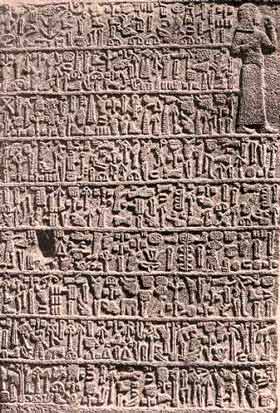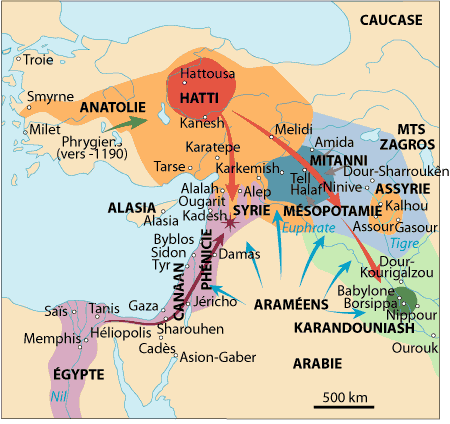Observe thou that
which I command thee this day: behold, I drive out before thee the
Amorite, and the Canaanite, and the Hittite, and the Perizzite, and the
Hivite, and the Jebusite.
Deuteronomy
Four Great Civilizations
The Hittites
he Promised
Land lay at the meeting point of the tectonic plates of the great
civilizations of the ancient world. There were four great civilisations:
Egypt, Assyria, Mesopotamia and the Hittites, each of these had its
great king. What is interesting about the Hittites is their almost
sudden disappearance from history, in an extremely short period of time,
a few short decades towards the latter part of the second millennium BC,
leaving behind them the ruins of their capital Hattusa in the arid
centre of Anatolia hundreds of kilometres from the Mediterranean.
The capital
of the great king was capable of resisting any attack, its walls six
kilometres long, up to eight metres thick with towers up to thirty
metres high. Hattusa had a capital of 50,000 persons, a vast royal
palace and a vast temple with two hundreds halls and rooms with dozens
of large public buildings.
Archaeologists found the ancient library of Hattusa with thirty thousand
cuneiform tablets, archived and classified in perfect order, the
greatest ancient library ever discovered. The language was totally
unknown to the world of archaeology, even though cuneiform was of common
use in those times by the Assyrians, Babylonians and Persians in writing
their languages.
The
language of the Hittites deciphered by a Czech was astonishing in that
it resembled no other Middle Eastern language, but belonged to the
Indo-European family of languages. The tablets told of a civilization
built on duty, discipline and sacrifice, and a vengeful god who could
inflict terrible punishment to those who did not respect the iron
discipline of the king and empire. The powerful army built an Empire
that stretch from the Aegean down to the frontiers of Egypt, which was
then just to the north of what is modern day Israel.
In 1279,
Ramses II reigned over Egypt, his empire met with that of the Hittites
near the ancient city of Kadesh close to the borders of present day
Syria and the Lebanon. It was here the greatest battle the world had
ever known until that time, the Battle of Kadesh, where the chariots of
the Hittites carrying three warriors, of a superior design to those of
the Egyptians that carried two, clashed in a terrible battle. History
recorded the victory of Ramses II, but the library in the ruins of
Hattusa uncovered the peace treaty signed between the two great kings,
which showed that the Hittites had imposed their forces over the
Egyptians pushing the frontier of their empire hundreds of kilometres
south into today's Israel, thus becoming the greatest empire of the
ancient world. Later a permanent peace treaty was concluded between
Ramses II and the Hittite King Hattusilis III.

A few short
decades later the Hittites disappeared from history for unexplained
reasons, until a new discovery was made by modern archaeologists in
their excavations at Hattusa. A series of indecipherable hieroglyphs
were discovered in an underground area, after much research this were
finally translated telling how the winner of the Battle of Kadesh and
the great king launched themselves into a fratricidal war. Hattusa was
destroyed, designed to resist an external enemy it could be defended by
an enemy from inside.
The
archaeologist discovered the palace and temples had been burnt down, but
not in war, they concluded the city had been abandoned, the population
taking with them everything that could be carried. The city had been
evacuated. Where they went is a mystery, but in any case the Hittites
disappeared forever from history, victims of their own cupidity.
The lesson
of this story is its comparison with biblical Jerusalem. Hattusa was the
centre of a great empire, its vestiges are still visible today after
more than three thousand years. Not a stone remains to confirm the
existence of the biblical empire of Solomon and David, which according
to the Bible was in its making at the time the Egyptians battled with
the Hittites at Kadesh.
go back to previous
page

